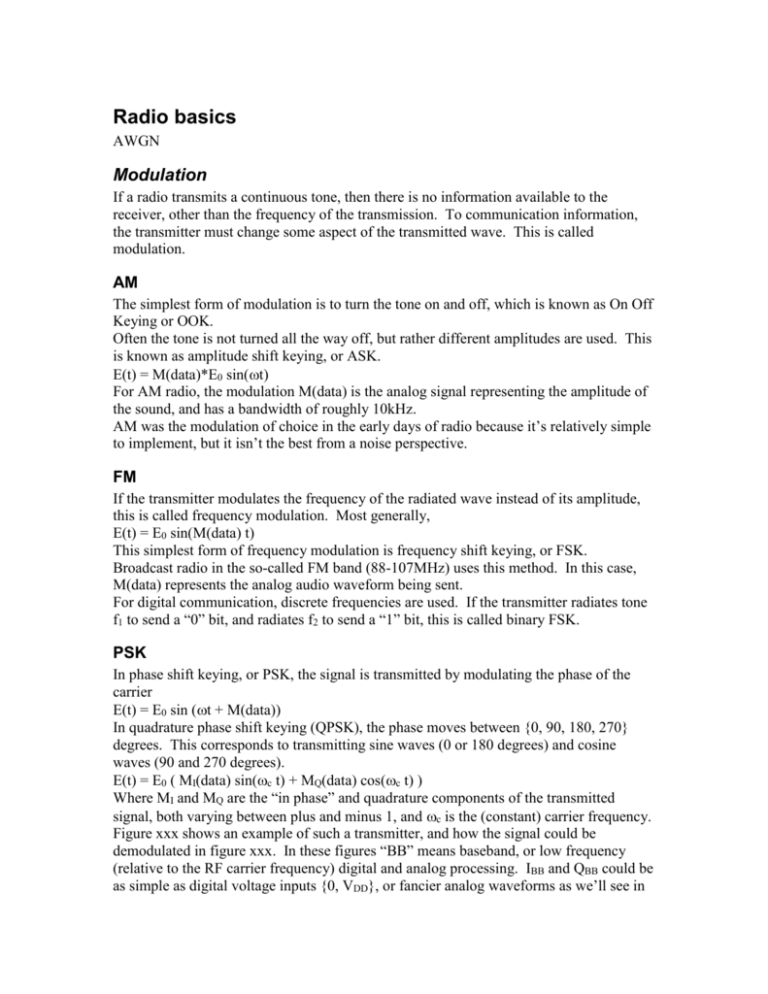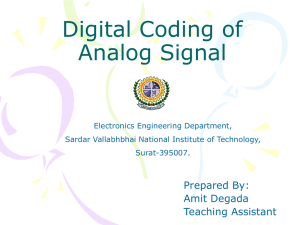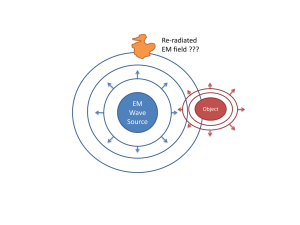Radio basics
advertisement

Radio basics
AWGN
Modulation
If a radio transmits a continuous tone, then there is no information available to the
receiver, other than the frequency of the transmission. To communication information,
the transmitter must change some aspect of the transmitted wave. This is called
modulation.
AM
The simplest form of modulation is to turn the tone on and off, which is known as On Off
Keying or OOK.
Often the tone is not turned all the way off, but rather different amplitudes are used. This
is known as amplitude shift keying, or ASK.
E(t) = M(data)*E0 sin(t)
For AM radio, the modulation M(data) is the analog signal representing the amplitude of
the sound, and has a bandwidth of roughly 10kHz.
AM was the modulation of choice in the early days of radio because it’s relatively simple
to implement, but it isn’t the best from a noise perspective.
FM
If the transmitter modulates the frequency of the radiated wave instead of its amplitude,
this is called frequency modulation. Most generally,
E(t) = E0 sin(M(data) t)
This simplest form of frequency modulation is frequency shift keying, or FSK.
Broadcast radio in the so-called FM band (88-107MHz) uses this method. In this case,
M(data) represents the analog audio waveform being sent.
For digital communication, discrete frequencies are used. If the transmitter radiates tone
f1 to send a “0” bit, and radiates f2 to send a “1” bit, this is called binary FSK.
PSK
In phase shift keying, or PSK, the signal is transmitted by modulating the phase of the
carrier
E(t) = E0 sin (t + M(data))
In quadrature phase shift keying (QPSK), the phase moves between {0, 90, 180, 270}
degrees. This corresponds to transmitting sine waves (0 or 180 degrees) and cosine
waves (90 and 270 degrees).
E(t) = E0 ( MI(data) sin(ct) + MQ(data) cos(ct) )
Where MI and MQ are the “in phase” and quadrature components of the transmitted
signal, both varying between plus and minus 1, and c is the (constant) carrier frequency.
Figure xxx shows an example of such a transmitter, and how the signal could be
demodulated in figure xxx. In these figures “BB” means baseband, or low frequency
(relative to the RF carrier frequency) digital and analog processing. IBB and QBB could be
as simple as digital voltage inputs {0, VDD}, or fancier analog waveforms as we’ll see in
the next section. A mixer is just an analog multiplier, so IRF=IBB sin(c t). The sine wave
generator is called the “local oscillator”, or LO. Once the baseband I and Q waveforms
have been “mixed up” to the RF I and Q waveforms, they are added together, and fed into
a power amplifier which is designed to drive the antenna. The radiated electric field is
proportional to the sum of the I and Q signals.
IBB
mixer
IRF
B
B
sin(ct)
Data bits
IRF+QRF
ERAD ~ IRF+ QRF
LO
90
PA
cos(ct)
QBB
QRF
Figure 1 A simplified OQPSK transmitter.
On the receive side, the voltage from the antenna goes through a Low Noise Amplifier, or
LNA, and then is fed into another pair of mixers driven by another local oscillator. For
convenience we can assume that both of our local oscillators are at the carrier frequency,
but most radios actually employ intermediate frequencies which we can ignore.
The output voltage of the LNA is proportional to the transmitted field, or
VLNA ~ IRF+QRF = IBBsin(c t)+QBBcos(c t)
When the receiver multiplies this sum by a sine wave and then averages the output with a
low pass filter, the result is a low frequency component proportional to the baseband
phase of the input, and a much-attenuated high frequency signal.
VLNAsin(c t) = IBBsin2(c t)+QBBcos(c t)cosc t)
LPF
IRF+QRF
IBB
B
B
sin(ct)
Data bits
LO
QRF
90
LNA
cos(ct)
QBB
Figure 2 A simplified QPSK receiver.
OQPSK-HSS
In IEEE 802.15.4, the baseband outputs I and Q in the transmitter are not just binary, they
are “shaped”. The shape is a half-sine wave. So transmitting a “1” on the I channel looks
like a half-cycle of a 0.5MHz sine wave. The “0” looks the same, except it is the
negative half cycle rather than the positive half cycle. The Q channel is the same, but
shifted in time by 0.5us.
Figure 3 OQPSK-HSS with a 10MHz carrier frequency and 2Mbps data rate. Top to bottom: I
channel, Q channel, I+Q. The transmitted I and Q bits are [1 0] and [0 1]. Note the phase of the I
channel at 0.5 and 1.5us, and the phase of the Q channel at 1 and 2us. Compare to the phase of the
sum at those times.
Figure 4 OQPSK-HSS Demodulated. On the left we have the same I, Q, and I+Q signals as before,
but at much higher frequency (2.45GHz, too fast to be resolved on this scale). On the right, on top is
the output of the I-channel phase detector, and on bottom the output of the Q-channel phase
detector.
QAM
Modulation index
Occupied bandwidth
Most of the energy in the transmitted wave lies in a frequency band equal to twice the
sum of the frequency deviation and the frequency of the modulated data.
Carson’s Bandwidth Rule CBR = 2*(ff + fm )
Noise
The signal coming off of the antenna contains many other components in addition to the
received power from the transmitter. Most of these are from undesired radio
transmissions, which we will call interference, discussed below. Some of these are from
other man-made sources such as electric power distribution, electric sparks in rotating
equipment such as electric motors and spark plugs. Some noise is from natural sources
such as lightning and solar flares.
If all of these sources are removed, there is still one fundamental source of noise that
remains. That is the random motion of everything in the universe due to its temperature.
Indeed, this random motion defines the temperature.
In 19xx Boltzmann pointed out that entropy is the logarithm of probability (which is
enscribed on his tombstone) and from this simple discovery we end up with the result that
in every Hz of bandwidth there is fixed amount (kBT) of thermal noise power. In a
bandwidth B, the noise power coming out of the antenna is
PN, antenna = kBTB
This noise is additive white and Gaussian, or AWGN, meaning that the noise power is
independent of the signal power and simply adds to it, the noise is uniform over all
frequencies (white), and follows a Gaussian distribution.
This signal from the antenna enters the radio, and then sees a sequence of electronics that
includes filters, amplifiers, mixers, analog to digital converters, and digital hardware.
Between the antenna and the output of analog to digital converters, every piece of
electronics adds its own noise to the signal. All of this noise can be combined into one
number describing the effective noise added by the radio to the fundamental noise
coming from the signal received at the antenna. This added noise is called the radio noise
figure, NF.
PN = kBTB NF
The noise figure depends on the architecture of the radio, the skill of the designer, and the
power consumed by the radio electronics. Typical noise figures for cell phones are on the
order of 5 dB. For low power PAN radios 10dB. For 802.11 radios xxx dB.
Sensitivity
The sensitivity of a radio is the minimum received signal power required in order to
achieve a specified bit error rate or packet error rate.
The required signal power depends on the amount of noise present, and on the minimum
signal to noise ratio, SNR, needed by the ADC and digital electronics.
S = kBTB NF SNRmin
SNRmin depends on the specified error rate, the modulation used, the algorithm used for
demodulation and decoding, and the quality of the implementation of that algorithm.
For example, consider an ASK signal with a one to zero ratio of 2. If the signal to noise
ratio at the receiver is 9, then the noise voltage will have an RMS amplitude of 1/3 the
signal amplitude. Assuming that the noise is AWGN
Link Margin
The link margin is a measure of how much power can be lost between the transmitter and
the receiver. It is given by PT/PR, or in dB
S [dB]= PT [dBm]– PR [dBm]
For typical PAN radios, PT is between 1 and 10mW, and the sensitivity is between -90
and -100dBm, giving link margins of between 90 and 110dB.
Cell phone link margins are generally +40dBm- -100dBm= 140dB on the tower-to-phone
link, and +30dBm- -110dBm = 140dB on the phone to tower link.
Spread Spectrum
FHSS
Fast, slow, and channel-hopping.
DSSS
In direct sequence spread spectrum, the data to be transmitted is first expanded to a larger
number of bits and then transmitted. The receiver has more bits to work with to figure
out what the data must have been. For example, if the transmitter sends 00001111 to
represent a single “0” data bit, and sends 010101010 to represent a “1” data bit, then
many of the transmitted bits can be corrupted without preventing the receiver from
correctly receiving the data.
Chips, bits, and symbols
When bits of data are expanded into longer sequences of bits for transmission, each one
of the transmitted bits is called a chip.
Power Consumption
Startup
Figure 5 Radio current
consumption during an idle listen.








